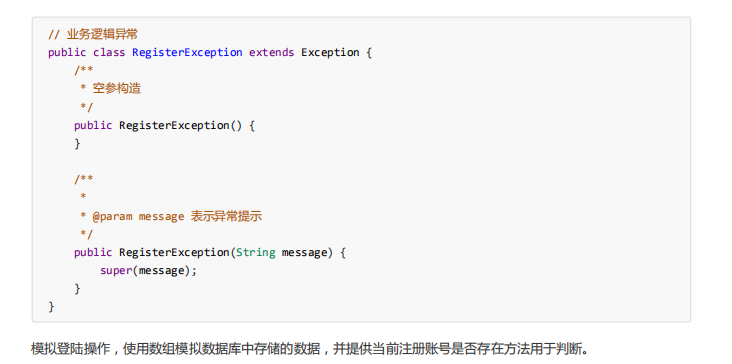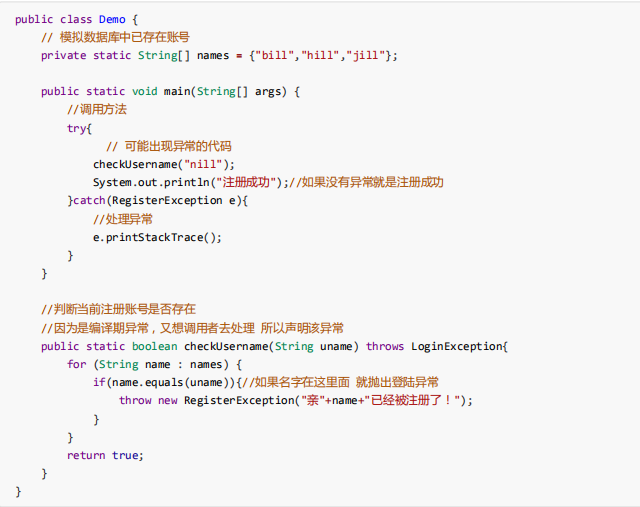异常
try。。。。catch
public class Demo02Exception { public static void main(String[] args) { //创建int类型的数组,并赋值 int[] arr = {1,2,3}; int e = getElement(arr,3); System.out.println(e); } /* 定义一个方法,获取数组指定索引处的元素 参数: int[] arr int index */ public static int getElement(int[] arr,int index){ int ele = arr[index]; return ele; } }
try...catch:异常处理的第二种方式,自己处理异常 格式: try{ 可能产生异常的代码 }catch(定义一个异常的变量,用来接收try中抛出的异常对象){ 异常的处理逻辑,异常异常对象之后,怎么处理异常对象 一般在工作中,会把异常的信息记录到一个日志中 } ... catch(异常类名 变量名){ } 注意: 1.try中可能会抛出多个异常对象,那么就可以使用多个catch来处理这些异常对象 2.如果try中产生了异常,那么就会执行catch中的异常处理逻辑,执行完毕catch中的处理逻辑,继续执行try...catch之后的代码 如果try中没有产生异常,那么就不会执行catch中异常的处理逻辑,执行完try中的代码,继续执行try...catch之后的代码 */ public class Demo01TryCatch { public static void main(String[] args) { try{ //可能产生异常的代码 readFile("d:\a.tx"); System.out.println("资源释放"); }catch (IOException e){//try中抛出什么异常对象,catch就定义什么异常变量,用来接收这个异常对象 //异常的处理逻辑,异常异常对象之后,怎么处理异常对象 //System.out.println("catch - 传递的文件后缀不是.txt"); /* Throwable类中定义了3个异常处理的方法 String getMessage() 返回此 throwable 的简短描述。 String toString() 返回此 throwable 的详细消息字符串。 void printStackTrace() JVM打印异常对象,默认此方法,打印的异常信息是最全面的 */ //System.out.println(e.getMessage());//文件的后缀名不对 //System.out.println(e.toString());//重写Object类的toString java.io.IOException: 文件的后缀名不对 //System.out.println(e);//java.io.IOException: 文件的后缀名不对 /* java.io.IOException: 文件的后缀名不对 at com.itheima.demo02.Exception.Demo01TryCatch.readFile(Demo01TryCatch.java:55) at com.itheima.demo02.Exception.Demo01TryCatch.main(Demo01TryCatch.java:27) */ e.printStackTrace(); } System.out.println("后续代码"); } /* 如果传递的路径,不是.txt结尾 那么我们就抛出IO异常对象,告知方法的调用者,文件的后缀名不对 */ public static void readFile(String fileName) throws IOException { if(!fileName.endsWith(".txt")){ throw new IOException("文件的后缀名不对"); } System.out.println("路径没有问题,读取文件"); } }
throw

public class Demo03Throw { public static void main(String[] args) { //int[] arr = null; int[] arr = new int[3]; int e = getElement(arr,3); System.out.println(e); } /* 定义一个方法,获取数组指定索引处的元素 参数: int[] arr int index 以后(工作中)我们首先必须对方法传递过来的参数进行合法性校验 如果参数不合法,那么我们就必须使用抛出异常的方式,告知方法的调用者,传递的参数有问题 注意: NullPointerException是一个运行期异常,我们不用处理,默认交给JVM处理 ArrayIndexOutOfBoundsException是一个运行期异常,我们不用处理,默认交给JVM处理 */ public static int getElement(int[] arr,int index){ /* 我们可以对传递过来的参数数组,进行合法性校验 如果数组arr的值是null 那么我们就抛出空指针异常,告知方法的调用者"传递的数组的值是null" */ if(arr == null){ throw new NullPointerException("传递的数组的值是null"); } /* 我们可以对传递过来的参数index进行合法性校验 如果index的范围不在数组的索引范围内 那么我们就抛出数组索引越界异常,告知方法的调用者"传递的索引超出了数组的使用范围" */ if(index<0 || index>arr.length-1){ throw new ArrayIndexOutOfBoundsException("传递的索引超出了数组的使用范围"); } int ele = arr[index]; return ele; } }
throws
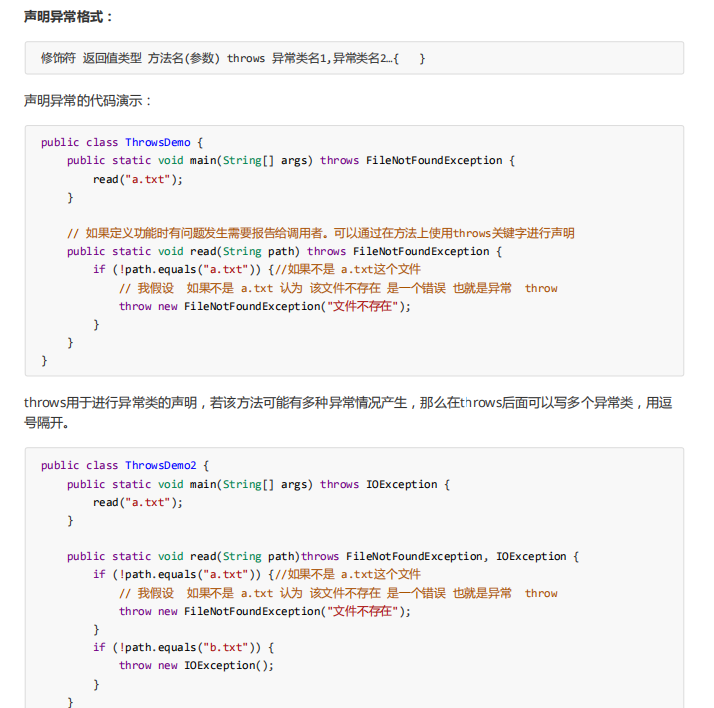
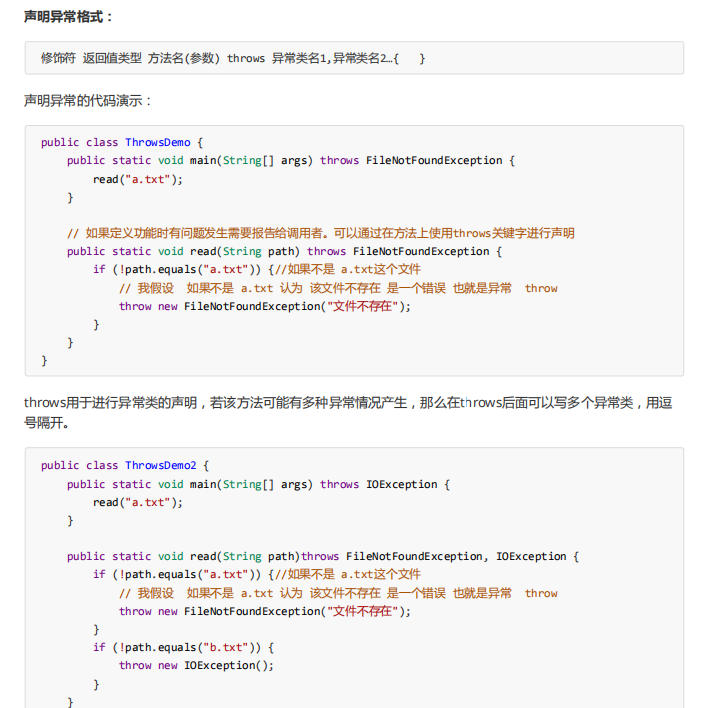
public static void main(String[] args) throws Exception { readFile("c:\a.tx"); System.out.println("后续代码"); } /* 定义一个方法,对传递的文件路径进行合法性判断 如果路径不是"c:\a.txt",那么我们就抛出文件找不到异常对象,告知方法的调用者 注意: FileNotFoundException是编译异常,抛出了编译异常,就必须处理这个异常 可以使用throws继续声明抛出FileNotFoundException这个异常对象,让方法的调用者处理 */ public static void readFile(String fileName) throws FileNotFoundException,IOException{ if(!fileName.equals("c:\a.txt")){ throw new FileNotFoundException("传递的文件路径不是c:\a.txt"); } /* 如果传递的路径,不是.txt结尾 那么我们就抛出IO异常对象,告知方法的调用者,文件的后缀名不对 */ if(!fileName.endsWith(".txt")){ throw new IOException("文件的后缀名不对"); } System.out.println("路径没有问题,读取文件"); } }
Objects 判断非空

public class Demo04Objects { public static void main(String[] args) { method(null); } public static void method(Object obj){ //对传递过来的参数进行合法性判断,判断是否为null /*if(obj == null){ throw new NullPointerException("传递的对象的值是null"); }*/ //Objects.requireNonNull(obj); Objects.requireNonNull(obj,"传递的对象的值是null"); } }
finally
有try或catch先走try或catch finally后走
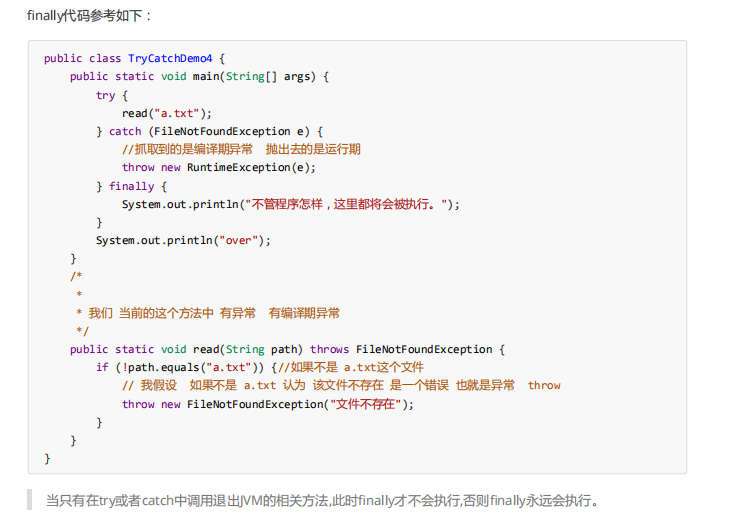
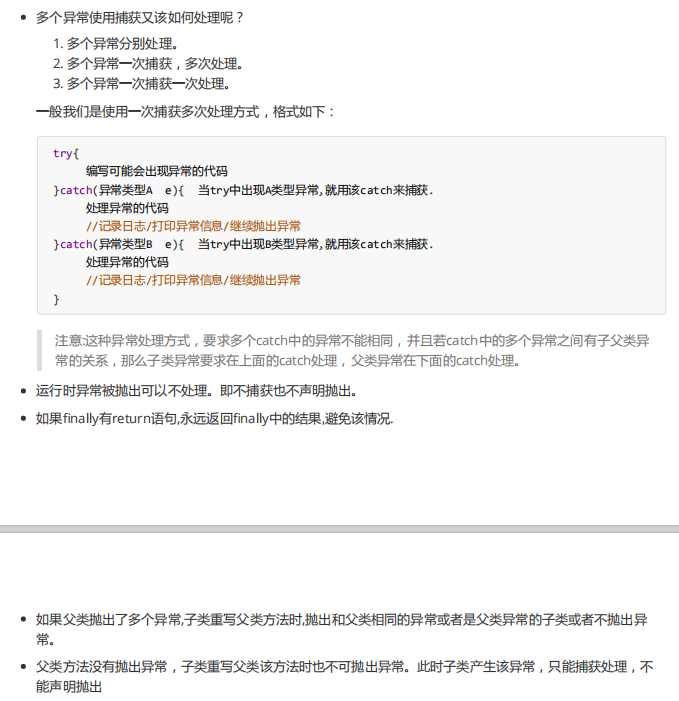
public class Fu { public void show01() throws NullPointerException,ClassCastException{} public void show02() throws IndexOutOfBoundsException{} public void show03() throws IndexOutOfBoundsException{} public void show04() {} 没有异常 } class Zi extends Fu{ //子类重写父类方法时,抛出和父类相同的异常 public void show01() throws NullPointerException,ClassCastException{} //子类重写父类方法时,抛出父类异常的子类 public void show02() throws ArrayIndexOutOfBoundsException{} //子类重写父类方法时,不抛出异常 public void show03() {} /* 父类方法没有抛出异常,子类重写父类该方法时也不可抛出异常。 */ //public void show04() throws Exception{} //此时子类产生该异常,只能捕获处理,不能声明抛出 public void show04() { 此处必能抛出异常只能try catch try { throw new Exception("编译期异常"); } catch (Exception e) { e.printStackTrace(); } }
package com.itheima.demo03.Exception; import java.util.List; /* 异常的注意事项 */ public class Demo01Exception { public static void main(String[] args) { /* 多个异常使用捕获又该如何处理呢? 1. 多个异常分别处理。 2. 多个异常一次捕获,多次处理。 3. 多个异常一次捕获一次处理。 */ //1. 多个异常分别处理。 /* try { int[] arr = {1,2,3}; System.out.println(arr[3]);//ArrayIndexOutOfBoundsException: 3 }catch (ArrayIndexOutOfBoundsException e){ System.out.println(e); } try{ List<Integer> list = List.of(1, 2, 3); System.out.println(list.get(3));//IndexOutOfBoundsException: Index 3 out-of-bounds for length 3 }catch (IndexOutOfBoundsException e){ System.out.println(e); }*/ //2. 多个异常一次捕获,多次处理。 /*try { int[] arr = {1,2,3}; //System.out.println(arr[3]);//ArrayIndexOutOfBoundsException: 3 List<Integer> list = List.of(1, 2, 3); System.out.println(list.get(3));//IndexOutOfBoundsException: Index 3 out-of-bounds for length 3 }catch (ArrayIndexOutOfBoundsException e){ System.out.println(e); }catch (IndexOutOfBoundsException e){ System.out.println(e); }*/ /* 一个try多个catch注意事项: catch里边定义的异常变量,如果有子父类关系,那么子类的异常变量必须写在上边,否则就会报错 ArrayIndexOutOfBoundsException extends IndexOutOfBoundsException */ /*try { int[] arr = {1,2,3}; //System.out.println(arr[3]);//ArrayIndexOutOfBoundsException: 3 List<Integer> list = List.of(1, 2, 3); System.out.println(list.get(3));//IndexOutOfBoundsException: Index 3 out-of-bounds for length 3 }catch (IndexOutOfBoundsException e){ System.out.println(e); }catch (ArrayIndexOutOfBoundsException e){ System.out.println(e); }*/ //3. 多个异常一次捕获一次处理。 /*try { int[] arr = {1,2,3}; //System.out.println(arr[3]);//ArrayIndexOutOfBoundsException: 3 List<Integer> list = List.of(1, 2, 3); System.out.println(list.get(3));//IndexOutOfBoundsException: Index 3 out-of-bounds for length 3 }catch (Exception e){ System.out.println(e); }*/ //运行时异常被抛出可以不处理。即不捕获也不声明抛出。 //默认给虚拟机处理,终止程序,什么时候不抛出运行时异常了,在来继续执行程序 int[] arr = {1,2,3}; System.out.println(arr[3]);//ArrayIndexOutOfBoundsException: 3 List<Integer> list = List.of(1, 2, 3); System.out.println(list.get(3));//IndexOutOfBoundsException: Index 3 out-of-bounds for length 3 System.out.println("后续代码!"); } }
自定义异常
